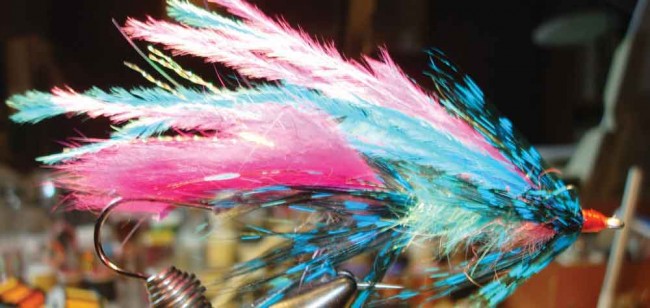
Photo Credit: Brian Smith
Brian’s fly pattern for landing steelhead
To many fly fishers, steelheads are the ultimate quarry. They are predominantly wild origin, swim in the most beautiful of places, and are aggressive to the cast fly.
When I’m working on new patterns at my fly-tying bench, I like to think of the fly from start to finish in the following order: the hook and its size, length, style, purpose and swimming action; the colours, both dark and light hues and their combinations; and finally the materials, using combinations of natural and synthetic fibres to capture the look and flow of being alive. Let’s break these down.
Hooks: Steelhead flies are tied in traditional, classic styles with up-turned eyes on curved single hooks or the more recent intruder styles with trailing “stinger” hooks. Both styles are effective; however, flies tied on trailer or stinger hooks present a larger target, undulate with current flows and are deadly at hooking fish that are plucking at the fly from behind. I now tie most of my wet (sinking) fly patterns using articulated-shanked hooks or will make my own with Tuf-Line wire.
Colours: You can’t go wrong with black, silver doctor blue, hot pink, purple and combinations of two of these colours. Experiment—you’re allowed! The old saying “bright day, bright fly; dark day, dark fly” is a good rule to follow.
Materials: I like dyed natural furs like rabbit strip for tails, ostrich and polar bear for wings, seal’s fur dubbing or mohair for bodies and guinea, mallard flank or marabou for hackles and collars. When I want flash, I use body-matching colours of Krystal Flash or Flashabou mixed with the tail fibres and will often substitute ice-dub for seal’s fur on bodies.
To construct Brian’s Deceiver in pink and blue, first take a 10-cm piece of 25-pound Tuf-Line, double it and pass it through the trailer hook’s eye. Pass the hook through the loop in the wire, pull snug and bind the wire securely to the hook shank with 3/0 Monocord. Cement the wire with super glue or five-minute epoxy.
Next, dub a tag of seal’s fur to the hook shank. Attach a five-cm length of rabbit zonker strip, trailing it to the end of the stinger hook. Fasten flash materials, extending them over the rabbit strip. Tie in the guinea feather by the tip, make four to six turns around the shank and bind them to flow backward.
Finally, dub a slim body of ice dub. Finish with the second collar: seal’s fur, ostrich strands and guinea hackle. Finish with a nice head: super glue the head and finish with tying cement.
Materials for Brian’s Deceiver
Hook: Mustad S74 # 4 streamer hook (clipped after tying the fly); Gamakatsu Octopus # 1 trailer hook
Thread: UTC 140 red
Tag: seal’s fur dubbing hot pink
Tail: rabbit zonker strip hot pink; to end of trailer hook
Flash: Krystal Flash pearl, three to four strands; three to four strands Flashabou pink
Collar 1: guinea feather silver doctor blue
Body: ice dubbing, silver doctor blue
Collar 2: seal’s fur dubbing, hot pink; three to four strands each ostrich feather strands pink over blue and lengths of body, finished with a collar of four to six turns guinea silver doctor blue




